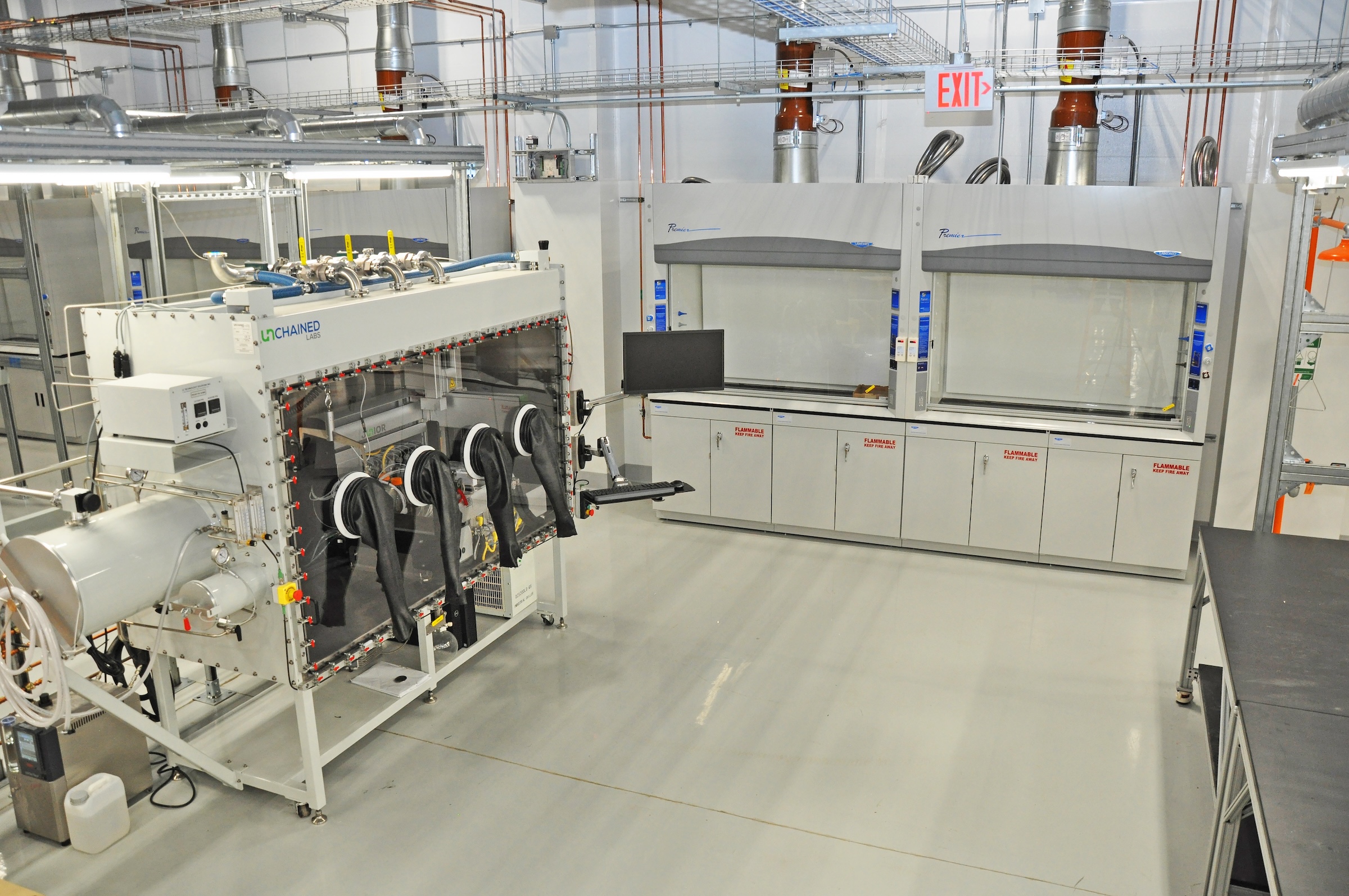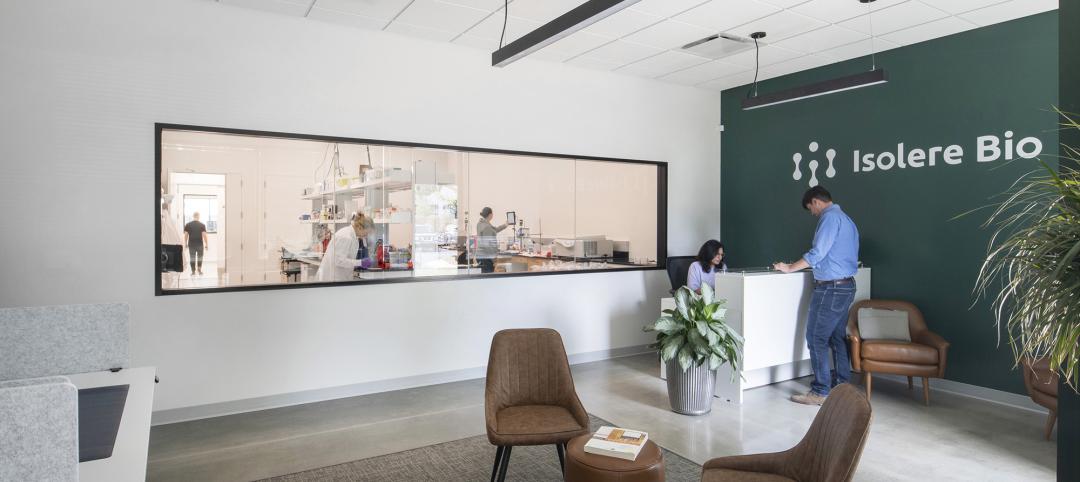Much has been made lately about converting vacant office space to laboratory use. However, with growing inventory in warehouse space as the distribution center market flattens, adaptive reuse of available warehouse space for life sciences applications is a concept that is coming to the fore. While it is not a simple conversion, it is easier than office space. This reallocation commands higher rent which is compelling for owners or developers who are facing current and future vacancies. This conversion can also be applied to laboratory cold storage, cGMP storage, or cGMP production.
What makes warehouse space ideal for conversion to laboratory use?
Warehouse space is essentially a large empty shell with open space and high ceilings which, ideally, is placed along major routes and supply chain corridors. These factors make it ideal for lab conversions. For office to lab, you may encounter slab-to-slab height restrictions that squeeze the ability to fit in the actual lab space requirements. Plus, the infrastructure, like ventilation, plumbing and power that is essential to a functioning life science application could be restricted.
Warehouse layouts provide space flexibility that can be used for multiple purposes, such as lab space for research, areas for product development or production, warehouse space for storage and on-site testing facilities all under one massive roof. Any one of which could be the entirety of the facility.
While it may be ideal on paper to initiate a conversion, there are important considerations that a developer should understand from the onset of a potential project which can drive up costs and could derail the project.
1. Roof structure considerations
A warehouse roofing structure does not typically allow for the use of heavy equipment that is standard in a laboratory environment, such as cooling towers or custom air handling units. Structural retrofitting is required to increase weight bearing capacities. This could involve creating a whole new structural system or, at a minimum, dropping new columns to support and distribute the weight.
In some circumstances, a standalone structural system or an interstitial space can be built within the framework of the existing warehouse which is independent of the original “shell” of the structure. This reduces the overall area that needs to be supported and gives the flexibility of a two-level system layout with mechanical and/or electrical equipment on the upper level and storage on the lower level.
Another alternative would be to run new columns all the way up through the roof and adding more steel to the structure to support the equipment above the roofline. Development of structural options must be considered for the actual use case scenario for optimal infrastructure design.
2. Air change rates
Laboratories require strict air change rates that are set by the American Society of Heating, Refrigerating and Air Conditioning Engineers (ASHRAE), with additional requirements that may be dictated by the National Institute of Health (NIH) and the Center for Disease Control (CDC). (1) Basic lab ventilation requires 6 to 12 air changes per hour and can climb upwards of 20 air changes per hour for cGMP spaces. So, creating a 10-foot lab room versus leaving the original 23-foot warehouse height would allow for lower Cubic Feet per Minute (CFM) rates and would not create air volume inefficiency.
One way this can be achieved is by creating a ceiling lid to the new lab space. In this scenario, the ceiling is located at a certain lower elevation and sealed. Then a plenum is added above the ceiling within the space up to the deck. This will give you the required air change rates and pressurization within a more compact space which utilizes less resources, energy and money.
Additionally, plug and play modular systems—pre-built labs that include HVAC systems—can be placed directly within the warehouse structure. These “pods” are connected to a remote condensing unit on the roof with refrigerant lines to quickly create a fully contained lab. New design options are being developed all the time and will only increase the effectiveness of using older warehouse spaces for this repurpose.
3. Plumbing, gas, and power
Water, gas, and power requirements could be exponentially higher in a laboratory environment. Standard lab infrastructure will require special sinks, washing/sanitizing facilities, and waste neutralization. Not to mention the water use of the actual equipment. All of this increases the wastewater management at the location and may require a larger water line for the facility.
Gas pipelines into the warehouse may not be adequate to run HVAC operations and will need to expand to meet new capacity requirements. Electrical service may need to be replaced due to its age, reliability and lack of sufficient capacity. The facility may also require emergency power that is not currently available. All these new services will require space and capital costs to upgrade, replace or install.
In converting existing warehouses to lab type spaces, some owners have chosen to provide for future flexibility by providing scalable infrastructure now. This prepares for additional capacities in case of a future retrofit that requires greater volumes later.
Do your due diligence
Exploration of this kind of facility conversion, and new market pursuits, requires due diligence to understand the factors that could impact whether your facility is suited for the laboratory market. We recommend starting with a facilities assessment study of your warehouse to have a full understanding of your actual structure, condition and capacity of existing equipment, and the anticipated new loads for electric, water, gas and fire protection. Based upon the assessment, a review of current local permit processes and zoning restrictions would also be recommended to see if there could be anticipated permitting delays for the conversion. From there, a developer/owner can truly determine if increased rental income and tenant occupancy outweighs the conversion costs to a life sciences piece of real estate.
1. Laboratory News – “Converting offices to laboratory space – understanding the needs of the LSCG sector” – Steven Anderson, Jonathan Andrew - 6/2021
Related Stories
Laboratories | Apr 22, 2024
Why lab designers should aim to ‘speak the language’ of scientists
Learning more about the scientific work being done in the lab gives designers of those spaces an edge, according to Adrian Walters, AIA, LEED AP BD+C, Principal and Director of SMMA's Science & Technology team.
Laboratories | Apr 15, 2024
HGA unveils plans to transform an abandoned rock quarry into a new research and innovation campus
In the coastal town of Manchester-by-the-Sea, Mass., an abandoned rock quarry will be transformed into a new research and innovation campus designed by HGA. The campus will reuse and upcycle the granite left onsite. The project for Cell Signaling Technology (CST), a life sciences technology company, will turn an environmentally depleted site into a net-zero laboratory campus, with building electrification and onsite renewables.
Laboratories | Apr 12, 2024
Life science construction completions will peak this year, then drop off substantially
There will be a record amount of construction completions in the U.S. life science market in 2024, followed by a dramatic drop in 2025, according to CBRE. In 2024, 21.3 million sf of life science space will be completed in the 13 largest U.S. markets. That’s up from 13.9 million sf last year and 5.6 million sf in 2022.
Sustainability | Mar 21, 2024
World’s first TRUE-certified building project completed in California
GENESIS Marina, an expansive laboratory and office campus in Brisbane, Calif., is the world’s first Total Resource Use and Efficiency (TRUE)-certified construction endeavor. The certification recognizes projects that achieve outstanding levels of resource efficiency through waste reduction, reuse, and recycling practices.
University Buildings | Feb 21, 2024
University design to help meet the demand for health professionals
Virginia Commonwealth University is a Page client, and the Dean of the College of Health Professions took time to talk about a pressing healthcare industry need that schools—and architects—can help address.
Urban Planning | Feb 5, 2024
Lessons learned from 70 years of building cities
As Sasaki looks back on 70 years of practice, we’re also looking to the future of cities. While we can’t predict what will be, we do know the needs of cities are as diverse as their scale, climate, economy, governance, and culture.
Laboratories | Feb 5, 2024
DOE selects design-build team for laboratory focused on clean energy innovation
JE Dunn Construction and SmithGroup will construct the 127,000-sf Energy Materials and Processing at Scale (EMAPS) clean energy laboratory in Colorado to create a direct path from lab-scale innovations to pilot-scale production.
Laboratories | Jan 25, 2024
Tactical issues for renovating university research buildings
Matthew Plecity, AIA, ASLA, Principal, GBBN, highlights the connection between the built environment and laboratory research, and weighs the benefits of renovation vs. new construction.
Laboratories | Jan 22, 2024
Speculative vs purpose-built labs: Pros and cons
Hanbury's George L. Kemper, AIA and R. David Cole, AIA share the unique advantages and challenges of both spec. and purpose-build labs.
University Buildings | Jan 18, 2024
Houston’s Rice University opens the largest research facility on its core campus
Designed by Skidmore, Owings & Merrill (SOM), the 251,400-sf building provides students and researchers with state-of-the-art laboratories, classrooms, offices, and a cafe, in addition to multiple gathering spaces.

















